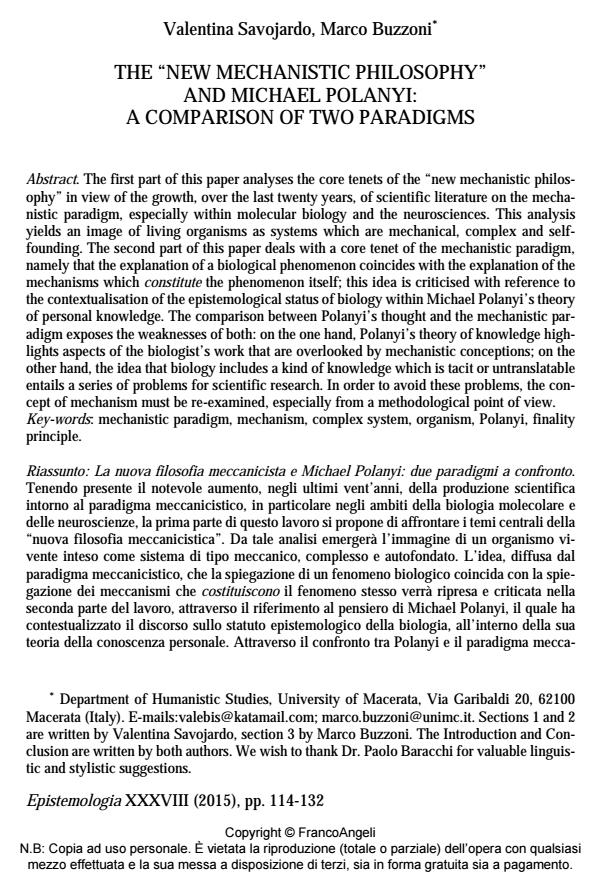The "new mechanistic philosophy" and michael polanyi: a comparison of two paradigms
Titolo Rivista EPISTEMOLOGIA
Autori/Curatori
Anno di pubblicazione 2015 Fascicolo 2015/1
Lingua Inglese Numero pagine 19 P. 114-132 Dimensione file 102 KB
DOI 10.3280/EPIS2015-001008
Il DOI è il codice a barre della proprietà intellettuale: per saperne di più
clicca qui
Qui sotto puoi vedere in anteprima la prima pagina di questo articolo.
Se questo articolo ti interessa, lo puoi acquistare (e scaricare in formato pdf) seguendo le facili indicazioni per acquistare il download credit. Acquista Download Credits per scaricare questo Articolo in formato PDF

FrancoAngeli è membro della Publishers International Linking Association, Inc (PILA)associazione indipendente e non profit per facilitare (attraverso i servizi tecnologici implementati da CrossRef.org) l’accesso degli studiosi ai contenuti digitali nelle pubblicazioni professionali e scientifiche
The first part of this paper analyses the core tenets of the "new mechanistic philosophy" in view of the growth, over the last twenty years, of scientific literature on the mechanistic paradigm, especially within molecular biology and the neurosciences. This analysis yields an image of living organisms as systems which are mechanical, complex and selffounding. The second part of this paper deals with a core tenet of the mechanistic paradigm, namely that the explanation of a biological phenomenon coincides with the explanation of the mechanisms which constitute the phenomenon itself; this idea is criticised with reference to the contextualisation of the epistemological status of biology within Michael Polanyi’s theory of personal knowledge. The comparison between Polanyi’s thought and the mechanistic paradigm exposes the weaknesses of both: on the one hand, Polanyi’s theory of knowledge highlights aspects of the biologist’s work that are overlooked by mechanistic conceptions; on the other hand, the idea that biology includes a kind of knowledge which is tacit or untranslatable entails a series of problems for scientific research. In order to avoid these problems, the concept of mechanism must be re-examined, especially from a methodological point of view.
Tenendo presente il notevole aumento, negli ultimi vent’anni, della produzione scientifica intorno al paradigma meccanicistico, in particolare negli ambiti della biologia molecolare e delle neuroscienze, la prima parte di questo lavoro si propone di affrontare i temi centrali della "nuova filosofia meccanicistica". Da tale analisi emergerà l’immagine di un organismo vivente inteso come sistema di tipo meccanico, complesso e autofondato. L’idea, diffusa dal paradigma meccanicistico, che la spiegazione di un fenomeno biologico coincida con la spiegazione dei meccanismi che costituiscono il fenomeno stesso verrà ripresa e criticata nella seconda parte del lavoro, attraverso il riferimento al pensiero di Michael Polanyi, il quale ha contestualizzato il discorso sullo statuto epistemologico della biologia, all’interno della sua teoria della conoscenza personale. Attraverso il confronto tra Polanyi e il paradigma mecca nicistico emergeranno i punti critici di entrambe le posizioni; se da un lato, attraverso l’epistemologia polanyiana, vengono alla luce alcuni aspetti del lavoro del biologo che i meccanicisti trascurano, dall’altro l’idea che la biologia sia attraversata da un tipo di sapere tacito o intraducibile crea una serie problemi alla ricerca scientifica. Per scongiurare un simile rischio, occorrerà riprendere e rivalutare il concetto di meccanismo, in particolare da un punto di vista metodologico.
Parole chiave:Paradigma meccanicistico, meccanismo, sistema complesso, organismo, Polanyi, principio di finalità
, The "new mechanistic philosophy" and michael polanyi: a comparison of two paradigms in "EPISTEMOLOGIA" 1/2015, pp 114-132, DOI: 10.3280/EPIS2015-001008